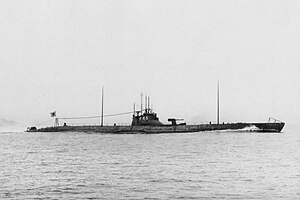
Back I-70 Spanish I-70 (sous-marin) French 伊号第七十潜水艦 Japanese I-70 Polish I-70 Ukrainian I-70 (tàu ngầm Nhật) Vietnamese
 I-65, similar to I-70, in 1932.
| |
| History | |
|---|---|
| Name | I-70 |
| Builder | Sasebo Naval Arsenal, Sasebo, Japan |
| Laid down | 25 January 1933 |
| Launched | 14 June 1934 |
| Completed | 9 November 1935 |
| Commissioned | 9 November 1935 |
| Decommissioned | 15 December 1938 |
| Recommissioned | by early 1940 |
| Homeport | Kure, Japan |
| Fate | Sunk 10 December 1941 |
| General characteristics | |
| Class and type | KD6 Type, Kadai type submarine |
| Displacement |
|
| Length | 322 ft 10 in (98.4 m) |
| Beam | 26 ft 11 in (8.2 m) |
| Draught | 15 ft 0 in (4.6 m) |
| Propulsion | Twin shaft Kampon 9,000 bhp (6,711 kW)/two stroke diesels |
| Speed | |
| Range | 14,000 nmi (26,000 km; 16,000 mi)[1] |
| Test depth | 230 ft (70 m) |
| Complement | 60–84 officers and enlisted |
| Armament |
|
I-70 was an Imperial Japanese Navy Kaidai-type cruiser submarine commissioned in 1935. While supporting the Japanese attack on Pearl Harbor at the beginning of the Pacific campaign of World War II in December 1941, she was sunk on the third day of the war, the first fleet submarine lost in the Pacific during the war.